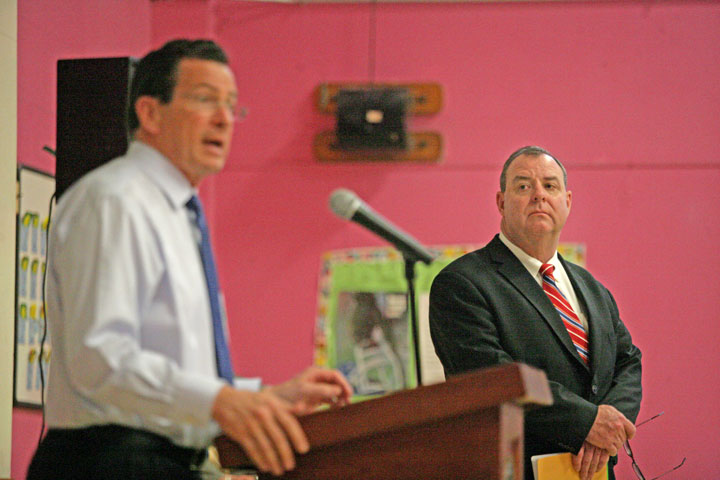Connecticut Governor Dannel Malloy paused for a reflective moment before entering a gymnasium packed with teachers opposing his education reform legislation at Walsh School, in Waterbury.
Story By Chelsea Murray, Photographs By John Murray
Steeled for battle, Governor Dannel Malloy took a deep breath, and entered the crowded gymnasium at Walsh School in the North End of Waterbury. On the evening of March 19th, Malloy made Waterbury the eighth stop of his Education Reform Tour, and he was prepared for a confrontation.
A week earlier the Governor’s message was drowned out by “boos”, and unruly behavior from the teachers’ unions at Wilbur Cross High School in New Haven. At previous stops Malloy’s reform tour was so heated that the Governor was in jeopardy of physical harm. As a consequence Waterbury police officers were out in full force. They protected every door, and the streets surrounding the school were barricaded. The gymnasium overflowed with a huge contingent of chattering teachers, concerned parents, community leaders, and a sprinkling of students. Mayor Neil O’Leary, a former police chief, set the tone by asking the crowd to be polite to the Governor, and show him some Waterbury hospitality.
After a short introduction from O’Leary and Malloy, the Governor fielded questions from the audience. O’Leary, usually the man answering the questions, found himself in the unlikely role of master of ceremony. He called out the name of an audience member who wished to address the Governor, and then sat three feet away while they posed their question. Having O’Leary’s forceful presence standing at the microphone was one way of keeping the speakers respectful and tame.

Waterbury Mayor Neil O’Leary, right, was the key figure in keeping Waterbury teachers and the audience respectful in comments to Governor Malloy.
The tension hovered in the room as hundreds of teachers awaited the opportunity to challenge the Governor and his controversial reform package. The teachers’ unions are a powerful political group in Connecticut, and Governor Malloy’s reform agenda was taking them head on.
Facing serious opposition, Malloy launched his reform tour to explain his proposals face to face to Connecticut residents in a town hall setting. Malloy believes the state’s education system is broken, and his reform legislation is an attempt to fix it.
Malloy told the audience that 40-60% of urban students are failing and the education system “is not working in Connecticut.”
This is not the first time Connecticut has attempted to mend the broken system. Governor Malloy acknowledged that Connecticut has tried to reform education in the past, but has failed at the very basic level, since the schools are still failing.
“We have been too timid when our situation calls for boldness and real reform,” Malloy wrote in a message on the Governor’s website. The package touches upon the issues of early childhood education, teaching to the test, overlooking critical thinking and student performance, bridging the achievement gap and targeting low performing urban schools.
Malloy’s 163-page education bill is intricate and complicated, yet the teachers’ unions have boiled it down to two contentious issues – tenure and teacher evaluations.
The Governor appeared to calm teacher unrest as he toured the state and quashed inaccurate information he said was being spread by union leaders. The Connecticut Education Association (CEA) produced a public service announcement claiming that Governor Malloy would be taking control away from the local schools and give the control to the state’s education commission, allow principals to decide which teachers are certified, and siphon tax dollars away from neighborhood schools.
The commercial said CEA has it’s own plans to improve education in Connecticut and it starts with more parental involvement and higher standards. But CEA has been accused of using emotional, fear-based information to sway public opinion about Malloy’s education reform, and to say that he “doesn’t get it right”. An editorial in the Hartford Courant on Friday, March 23, backed up Malloy and stated “sorry CEA, he does ‘get it right.’ Mr. Malloy’s reform plan would be a long-needed boost for Connecticut.”
The State Department of Education will not take an iron grip of all schools across the board as the CEA ad implies. The proposed package encourages the State Department of Education to take over local schools, but not every single one. They would take over the 25 lowest performing schools, mostly in urban areas, and aid them in bridging the achievement gap. Malloy says the government needs to take action and snap these schools to attention.
The one component of Malloy’s reform bill that has riled up teachers across the state is the Governor’s plan to standardize the teacher evaluation process. At the moment, there is no uniform guidelines to assess teacher performance, and the criteria used varies wildly from one school district to another, and from one principal to another.
The result of Malloy’s evaluation plan for teachers would set a consistent framework that would ensure students were getting the same education in their classrooms. The proposed reform package speaks about working on creating a framework, and for the first time in the history of the state of Connecticut, the principals will be evaluated as well. “There was never a fair Matrix in place to make those judgments (about educators),” Malloy said in response to a question about teacher’s evaluations.
An editorial in the USA Today on March 22 stated that, “teachers must be accountable for their performance, just like people in other lines of work.” Evaluating and observation of teachers, Malloy believes, is the key to improving the school systems.
A new standard evaluation procedure will make some educators quake in their shoes, but if they are good at their jobs, what’s the concern? This proposed reform to the education system appears radical and goes through a step-by-step process to explain how Connecticut can morph into a forwardly mobile state. It’s a comprehensive approach reaching it’s tentacles into all branches of educating a child, emphasizing on early childhood education, delivering more resources to lower performing districts and encouraging parental involvement and building charter schools.
A male teacher stepped up to the microphone to ask a question of the Governor pertaining to teacher tenure. He said the proposed package would put all teachers at risk, including tenured ones, and would remove tenured teachers if they did not pass the evaluation process. Malloy gave him a sharp look and responded, “you know that’s not the case. Clearly, that would be illegal and discrimination.”

Quickly squashing a belief that many of the audience members had in their heads, the fire in the audience began to dim. At a similar gathering in Torrington, Governor Malloy said, “everyone is talking about how we want to end tenure. That’s not true. I’m not saying let’s do away with tenure. I think it’s an appropriate protection. Tenure can not be used to protect people that are under performing. It’s not right for our kids.”
Governor Malloy and the state of Connecticut are not alone in this fight to champion education reform. In July 2011, President Obama emphasized the importance of education to aid the United States in continuing to compete for a top spot in the world power structure.
“A world-class education is the single most important factor in determining not just whether our kids can compete for the best jobs, but whether America can out-compete countries around the world,” Obama said. “America’s business leaders understand that when it comes to education, we need to up our game. That’s why we’re working together to put an outstanding education within reach for every child.”
The push to restructure the education system around the country started at the top with the federal government, therefore this “radical” package facing Connecticut is not as ground breaking as the teacher’s unions are making it out to be. Governor Malloy is not an evil tyrannical ogre slamming his fist down and imposing education reform that has never been heard of. Connecticut is attempting to aid it’s failing schools and compete on a national and global level the way many other states have done, including our neighbors Massachusetts, Rhode Island and New York.
“Suffice it to say that we aren’t doing anything in this package that has not been done in other states,” Malloy told the gathering inside Walsh School. “31 states have engaged in looking at evaluations and tenure and just since 2009, 23 states have coupled those things together including RI, Mass and NY, which are states that we touch.”

Malloy pointed out that Massachusetts has been reforming the education system for about ten years and it is the clear reason that their test scores are going up. Governor Malloy said that Connecticut looked at states with similar demographics such as Maryland, New Jersey, Massachusetts and Rhode Island to compare before drawing up the education reform package. All of those states have seen huge gains in test scores, and Connecticut has not.
In the beginning of his statewide tour, Malloy was met with disdain and just about sparking teacher union led riots. Whomever had taken over the Governor’s office, Republican or Democrat, was going to be faced with a tremendous uphill climb. Governor Malloy has piled dozens of issues on his back to try and steady Connecticut during this economic crisis. He was greatly vilified his entire first year in office because of the drastic approaches he was taking to keep the state from falling apart. The initial reactions to his Education Reform package appeared to be a deathblow for the first term Governor until he began to sway opinions. As he made his way around the state, the teacher’s unions started to calm and the general public started to hear the truth about what he was trying to do to fix a broken system. Everyone appears to have the same common goal, which is to help the students succeed and pull Connecticut out of the mud.
A new Quinnipiac University poll says 44 percent approve and 45 disapprove of the job Malloy is doing in office. He doesn’t make strategic political decisions to keep himself in office, he says he does what he believes is right for Connecticut.
As Governor Malloy moved across the state speaking in a variety of forums, the mood shifted from hostile to favorable towards his proposed package. The main goal is to move Connecticut forward and put the betterment of the children’s education first.
At the end of March the State Legislature removed several key components of Malloy’s package, but the Governor is intent on fighting to keep all his proposed measures in play. Now instead of going from forum to forum around the state, the Governor is going to have to roll up his sleeves and convince state representatives and state senators to take the plunge with him.
“We all know in our heart of hearts that something’s got to give,” Malloy said. “We have to do this for our children.”

